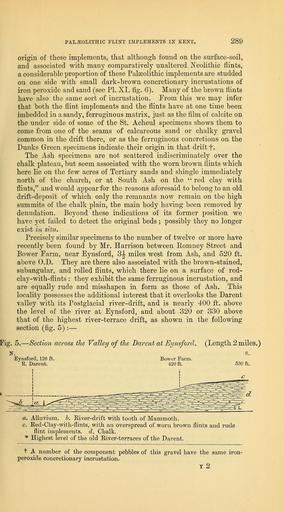MAKE A MEME
View Large Image

| View Original: | The_Quarterly_journal_of_the_Geological_Society_of_London_(13937160882).jpg (1166x2104) | |||
| Download: | Original | Medium | Small | Thumb |
| Courtesy of: | commons.wikimedia.org | More Like This | ||
| Keywords: The Quarterly journal of the Geological Society of London (13937160882).jpg PALEOLITHIC FLINT IMPLEMENTS IN KENT 291 <br> affords however better evidence of glacial action This gravel which <br> consists in greater part of perfectly angular and unrolled white flints <br> with a few Tertiary pebbles and occasionally with fragments of chert <br> is unstratified and looks as though it had been forced down irregu- <br> larly as it were into the underlying Gault by pressure from above <br> The flints are often pitted or pock-marked The section however <br> at Park-Farm brick-pit is small and insufficient This gravel is <br> better developed and possesses more distinctive characters in other <br> parts of the Holmesdale valley and I will therefore reserve the fuller <br> account of it to a future occasion when I shall be able to give more <br> definite reasons for its origin <br> I showed many years ago that the great trough or valley of <br> Holmesdale in which this drift has been deposited is of more <br> recent date than the extensive spread of red clay with flints <br> which lies on the top of the chalk hills Consequently the brown- <br> stained flint- drift which has now been traced to the edge of the <br> escarpment where like the red clay it suddenly ends together <br> probably with the associated rude flint implements must also be of <br> older date than the valley and therefore anterior to the Postglacial <br> river-drifts of these tributaries of the Medway and the Thames <br> valleys which lie in them I have also shown f that there has been <br> at a time probably before that of the northern drift or Boulder-clay <br> series a drift from the south which carried the chert and ragstone of <br> the Lower Greensand across the chalk-escarpment into the Thames <br> valley ” not in the line of the present river-valleys but traversing <br> the high chalk plain and capping the summit of some of the higher <br> hills in the London basin Still it seems not to be universally <br> distributed but to keep to certain lines springing from the lower <br> but still high points or gaps in the chalk-escarpment J Amongst <br> the drift-capped hills of the Thames valley is that of Swanscombe <br> Wood 51 miles north of Ash and 306 ft § above J It consists <br> of an outlier of London Clay with a capping of this southern drift <br> which there consists according to a note I made some years ago <br> of a small shallow section then existing by the Old Telegraph of ” <br> Tertiary flint pebbles Woolwich beds <br> Subangular fragments of brown chert 1 <br> ž ž of bright red chert Lower Greensand <br> ž of yellow ragstone J <br> Subangular flints not coloured <br> Flints much rolled and worn and stained deep brown <br> Green-coated flints Thanet Sands <br> The above are placed in the order of their relative abundance <br> The brown and red cherts are from the Lower Greensand of the <br> On the Origin of the Sand and Gravel Pipes in the Chalk c Quart <br> Journ Geol Soc vol xi p 73 1854 <br> t Eeports Brit Assoc York 1881 p 621 <br> I Thus far this brown flint-drift appears to be generally associated with rude <br> flint implements ; but the inquiry is yet new and needs more extended obser- <br> vations <br> § This is 220 ft above the high-level terrace of implement-bearing river- <br> gravel at Swanscombe 36940084 113696 51125 Page 289 Text 45 http //www biodiversitylibrary org/page/36940084 1889 Geological Society of London Biodiversity Heritage Library The Quarterly journal of the Geological Society of London v 45 1889 Geology Periodicals Smithsonian Libraries bhl page 36940084 dc identifier http //biodiversitylibrary org/page/36940084 smithsonian libraries Information field Flickr posted date ISOdate 2014-04-21 Check categories 2015 August 26 CC-BY-2 0 BioDivLibrary https //flickr com/photos/61021753 N02/13937160882 2015-08-26 05 52 41 cc-by-2 0 PD-old-70-1923 The Quarterly journal of the Geological Society of London 1889 Photos uploaded from Flickr by Fæ using a script | ||||